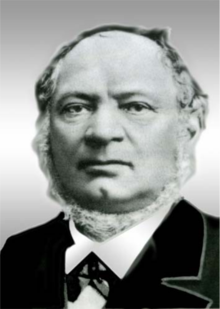Edmund Heusinger from Waldegg

Edmund Heusinger von Waldegg (born May 12, 1817 in Langenschwalbach , † February 2, 1886 in Hanover ) was a German architect , mechanical and railway engineer .
origin
He came from a parsonage in Nassau and, since his father could not afford the money for his studies, first had to complete an apprenticeship as a bookseller in Hanover. Here - and then in Leipzig - he made contacts and gained experience in publishing and publishing, which was, among other things, a starting point for his later extensive publication activities in the field of railway engineering. In addition, he invented a forerunner of the later rotary printing process . In Leipzig he studied physics , mathematics and mechanics . He also witnessed the opening of the Leipzig-Dresden Railway , which won him over to railway technology.
Railway engineer
In 1840 he took part in the assembly of a locomotive delivered in individual parts from England at the Gutehoffnungshütte in Sterkrade and accompanied the vehicle to the Taunus Railway . In 1841 he became foreman there, and in 1846 head of the central workshop. Here he developed a forerunner of the disc wheel .
In 1854 he was commissioned to plan the Homburg Railway . He then played a key role in the construction of the Deister Railway and the southern Harz line .
Inventions

In 1849 he invented a new type of control for steam locomotives, the Heusinger control named after him . It developed into the most common type of control worldwide. However, since the Belgian engineer Egide Walschaerts had already developed an almost identical control mechanism independently of Heusinger in 1844, the control of the type developed by Heusinger is also referred to as Walschaerts control outside the German-speaking area .
He also invented the express train car , the "Heusinger car", which, in contrast to the compartment carriages that had been predominantly used in Europe until then, had a side aisle inside the car and was therefore a through car . This meant that the running board that had previously run along the outside of the car and could only be used by train crews under considerable danger was superfluous. The Hessian Ludwigsbahn used this new type of car for the first time, and the Prussian State Railroad introduced it in series in 1892.
Another of his inventions was a field railway system for the army .
publicist
The manual for special railway technology , published by Edmund Heusinger von Waldegg and published by Verlag Wilhelm Engelmann in Leipzig in five volumes, was groundbreaking:
- Vol. 1: Railway construction (1st edition 1870)
- Vol. 2: The entire scope of the railway carriage construction (1st edition 1874)
- Vol. 3: Locomotive construction (1st edition 1875)
- Vol. 4: The technology of the operation with signaling and workshop facilities (1st edition 1876)
- Vol. 5: Construction and operation of the secondary and tertiary railways including the floating cable cars and cable cars (1st edition 1878, online )
In view of the rapid technical development, revised new editions were required in quick succession, in which volumes 1 to 3 and 5 were divided into sub-volumes due to the growing amount of material, some of them as so-called "atlas volumes" with images and drawings.
In addition to numerous essays and publications of his own, he founded the " Organ for the Advances in Railways in Technical Relation ", later the official organ of the Association of German Railway Administrations .
More fonts
- The lime, brick and pipe distillery, 2nd edition, Leipzig 1867. 3rd revised and many times enlarged edition 1876.
literature
- Erhard Born: Edmund Heusinger from Waldegg . In: Yearbook of the Railway System . 1955, pp. 209-220.
- Erhard Born: Heusinger von Waldegg, Edmund. In: New German Biography (NDB). Volume 9, Duncker & Humblot, Berlin 1972, ISBN 3-428-00190-7 , p. 48 f. ( Digitized version ).
- Bernhard Hager: Heusinger control, side walk car and "organ" . In: EisenbahnGeschichte 82 (June / July 2017), p. 32.
- Erich Preuß , Reiner Preuß : Lexicon of inventors and inventions. Railroad. Transpress, Berlin 1986, ISBN 3-344-00053-5 .
- Wolfgang Schivelbusch : History of the railway journey. On the industrialization of space and time in the 19th century. Fischer-Taschenbuch-Verlag, Frankfurt am Main 1989, ISBN 3-596-24414-5 ( Fischer - Geschichte 4414).
- Ernst Henrich u. a .: Edmund Heusinger von Waldegg - his time in Homburg and Gonzenheim . Historical working group Gonzenheim eV
Web links
- Literature by and about Edmund Heusinger von Waldegg in the catalog of the German National Library
Individual evidence
- ^ Franz Rudolf Zankl (ed.): List of architects , compiled with the collaboration of Helmut Zimmermann , in this: Hanover. From the old train station to the new town hall. Pictorial documents on urban development in the second half of the 19th century , exhibition guide of the Historisches Museum am Hohen Ufer, Hanover, 1975, p. 42 f.
- ↑ a b Preuss, p. 183.
- ↑ Schivelbusch, p. 82; Preuss, p. 184.
- ↑ Organ for the progress of the railway system (Wiesbaden: 1.1845 - 18.1863, new series 1 = 19.1864 - 81 = 99.1944.15 / 18 [Aug./Sept.], Full title up to 64 = 82.1927: body for the technical progress of the railway system Relationship; to this: supplementary volumes 1.1866 - 16.1925, up to 9.1884 named as supplementary volumes)
| personal data | |
|---|---|
| SURNAME | Heusinger von Waldegg, Edmund |
| BRIEF DESCRIPTION | German architect, mechanical engineer and railway pioneer |
| DATE OF BIRTH | May 12, 1817 |
| PLACE OF BIRTH | Langenschwalbach |
| DATE OF DEATH | February 2, 1886 |
| Place of death | Hanover , Lower Saxony |
